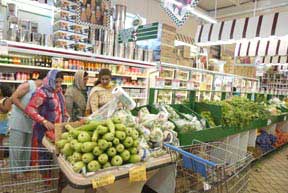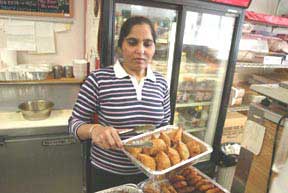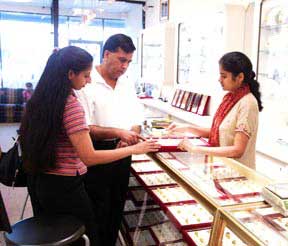Magazine
Hindville

Hicksville reclaims its old reputation as an Indian stronghold - this time of the desi variety.
|
The town of Hicksville in Long Island was an Indian stronghold before the arrival of the pilgrims. Not the desi variety, to be sure, but native American Indians.
And now interestingly enough, Indians are reclaiming the town back – the desi ones, this time! Yes, the Indianization of this all American town, situated in the Hempstead Plains, is taking place, one samosa at a time. Hicksville’s Indian residents are now in the happy position of having a lifetime’s supply of samosas for they have not one Indian grocery store, not two, not three, but half a dozen – all within shouting distance of each other! That’s probably more than most had back in their neighborhood in India. In fact, just over the course of this year at least four new stores have sprouted up, including two Sabzi Mandi stores on the same stretch of road. The aroma of tandoori food permeates restaurants and catering establishments, such as Punjabi Dhaba, Sher-E-Punjab catering, Kiran Palace and Rang Mahal. Want a dosa, you have House of Dosas. Feel like rasmalai, step into Rajbhog or Rasraj or Shaheen Sweets. And if you need to buy a kurta or get an outfit altered you don’t need to go to Jackson Heights or New Jersey – there are now several boutiques within a 2-mile radius. Hard to believe but just 15 years back, Hicksville had just one Indian grocery store. Rajesh Kumar, who owned Modern Bazaar, recalls that his was the only Indian store around. Yet slowly, a metamorphosis has taken place, driven by the rapid expansion of the Indian population in Long Island. According to the 2000 U.S. census figures, the Indian population in Long Island (comprising Nassau and Suffolk counties) almost doubled to 34,333 from 17,523 in 1990. The region is home to another 8,000 South Asians from Pakistan and Bangladesh. Hicksville has caught on as the center of Indian commerce for the entire Long Island region. Why Hicksville? According to Kumar, it’s got a lot to do with its central location, midpoint on the Long Island Expressway, and with Route 106-107 accessible from all directions. With the Hicksville railroad station being the transfer point for many travel destinations, the town has become a magnet for Indians who work in the city and yet look to have a suburban lifestyle and better education and housing for their families. The train journey to Penn Station in Manhattan takes just 45 minutes, and there are no traffic jams to face or tolls to pay.
“When they are progressing from Queens they are thinking it’s a better lifestyle for the next generation,” says Kumar, who now owns a Rajbhog franchise and a dollar store, and himself lives in Hicksville. He points out that all the neighboring towns like Woodbury, Syosset, East Meadow, Bethpage, and Westbury have large South Asian populations and for all of them Hicksville has become the hub, as well as for the people who are living much further east in Long Island, in Suffolk County. Many new immigrants are bypassing Queens altogether as they move to the suburbs directly, where their family members have already set roots. Businesses from Queens are also moving to Hicksville because of cheaper rents and better parking for their clients. Jai-ya, a popular Thai restaurant in Elmhurst with a largely Indian clientele, recently moved to Hicksville. The Indian population in Long Island doubled to 34,333 in the 1990s. “Hicksville has been a very stable community,” observes Reena Khera, a realtor with Century 21 Kaufman. Khera, who sells homes in Hicksville, says, “A lot of the Queens and Brooklyn Indians want to come into Hicksville. The prices of homes here have gone up a lot and I think the Indian community has a lot to do with it. They certainly have added value to the place.” She adds that the Indians are well respected and desired as neighbors, because they are helpful and hospitable. Census data shows that almost 5 percent of the population of Hicksville is South Asian. Sabita Mahtani, who has lived in Hicksville for 11 years, says, “There’s no need to go to Queens anymore, it’s nice, it’s not over-populated. And for my children, it’s really good for there are so many Indian children in school, they have Indian cultural programs. Hicksville High School has an Indian principal, Mrs. Brijinder Singh.” Hicksville boasts an Arya Samaj Temple as well as a Ram Mandir, and the neighboring town of Plainview has a Sikh Gurudwara. There’s a mosque in East Meadow, just three miles away, and Vedic Heritage of New York in the town of Hempstead. There are at least two catering halls, Antun and Imperial Manor, which are Indian-owned, and a host of Indian restaurants offer catering services. With their spiritual and material needs looked after, the South Asians of Long Island need travel no further than Hicksville. Satpal Malhotra, president of India Association of Long Island, recalls: “Way back in 1980 I told my wife about Hicksville, ”This is going to be the place’ and that’s what it’s turned out to be. Recently I went to the gurudwara in Plainview and one of the assistant granthis told me that within a month and a half a hundred Indian families have moved into the Hicksville area. There are so many new faces in the gurudwara.” “It is becoming another satellite center outside of Queens and New Jersey. I didn’t know there were so many Indians here,” observed Shailly Arora, a business manager at Wipro Technologies, as she shopped at an Indian boutique. “Since I travel to India three or four times a year, I don’t usually shop for clothes here, but the groceries are a real boon. They have everything so you don’t need to bring anything back from India.”
Patel Brothers does brisk business in its stand-alone supermarket, as do all the other grocery stores that have opened shop recently. The HIP Center with its many Indian doctors and patients is a stone’s throw away and many of the houses in the vicinity are Indian-owned. Sohail Butt from Pakistan owns Kashmir Groceries, which has a halal meat section to which Indian, Pakistani, Bangladeshi and Middle Eastern customers throng for goat meat and other meat cuts popular on the subcontinent. Butt has been there for five years has certainly seen a sea-change: “It’s increased tremendously. When I came here, you could hardly see an Indian or a Pakistani – they were so few!” The beauty business is also thriving. Kumar observes, “There are now ten beauty parlors in a one mile radius! Unbelievable! One every month for the past five months!” The list includes Aina, Sana, Trends, Femme, Roop and Habib. Yes, businesses are flourishing as the grocery stores, beauty saloons, jewelry stores and video stores have followed the burgeoning Indian population. Part of the equation lies in the fact that many of these businesses are also catering to the larger American population now. It is common to see white Americans and Hispanics picking their fruits, vegetables and milk at Indian grocery stores and yes, the occasional packet of samosas and spices too. Indian beauty saloons are also popular with the local population, because of the miracle of threading, which is very much an Indian phenomenon where unwanted facial hair is removed not by wax, creams or electrolysis, but by a simple thread and tooth power. Eyebrow shaping is particularly in demand by Hispanics and African Americans, whose hair quality is thick like that of the Indians.
Not only are Indian stores sprinkled along South Broadway down Route 107, but they have also carved a niche in Delco Plaza, a shopping mall with a mainstream King Kullen Supermarket and other must-haves of Americana – Blockbuster, Hollywood Tanning and Chuckee Cheese. At least seven Indian stores have inserted themselves into this all-American mall and are doing well, including an Indian restaurant. While there is a 22-carat gold jewelry store, East West with all the ornate wedding sets from India, there is also Vastra, which caters more to American customers. The owner, Poonam Jain, says that in a nod to the locals, they have included 14 carat as well as 18 carat to their 22 carat gold fare, and small diamond jewelry pieces, which are popular with their non-Indian clientele. Jain estimates there are more than 2,000 South Asian families in a 20-mile radius, which she researched from the Internet for her mailing list. As she jokes, with the new Singha Pizza opening in Hicksville, there’s now every kind of fast food that Indians could want, from dosas to chaat. “Now you’re not supposed to cook at home! Everything is available including ready-made foods. For under five dollars you can buy a good meal or dessert.” She is, however, firm in the belief that Hicksville will never become another Jackson Heights, which is so central to people driving in from Washington, Connecticut or Westchester. She points out that since mostly Indian professionals live on the island, they travel almost every year to India and so never buy big ticket items like jewelry here. “Yes, the food stores will come here, but if you think there will be 22 jewelry stores on one street like in Jackson Heights, that will not happen.”
Indians are opening stores with an eye on the mainstream – mixing and matching items. Amit Banot is following this strategy at his specialty store, Bombay Gourmet, which has not only Indian gourmet treats like Haldirams, Roopak Spices and Kwality ice-cream, but also olives, chocolates and exotic olive oils and pasta sauces found in mainstream gourmet stores. “My store is not a regular grocery store,” says Banot. “If someone wants to order a special eggless cake, be it Black Forest or with strawberry or custard filling, we can make it for them.” At the same time, he is catering to young Indian Americans who like gift giving the American way. So he makes special baskets with Indian spices and cookbooks and also special decorative baskets for rakhi or wedding ceremonies and decorative platters for the Indian festival of Karva chaut. Ladi Narang of Roopam Boutique is following a similar strategy to reach a larger customer base. “I have an Indian customer base, but Americans are also checking out our stuff and they really like it,” she says. “Two little American girls who had seen Bend It Like Beckham came in and they said ‘We want to wear Indian outfits on the first day of our school’ so that made me feel so good.” She adds: “Americans are also buying the kurtis, which are like short tunics to be worn with pants. We have started Indo-Western styles also so that we can attract more of the community as a whole and not just the Indian community. That’s how it has to be – you have to serve the larger community and I think it’s a very good start.”
|






You must be logged in to post a comment Login